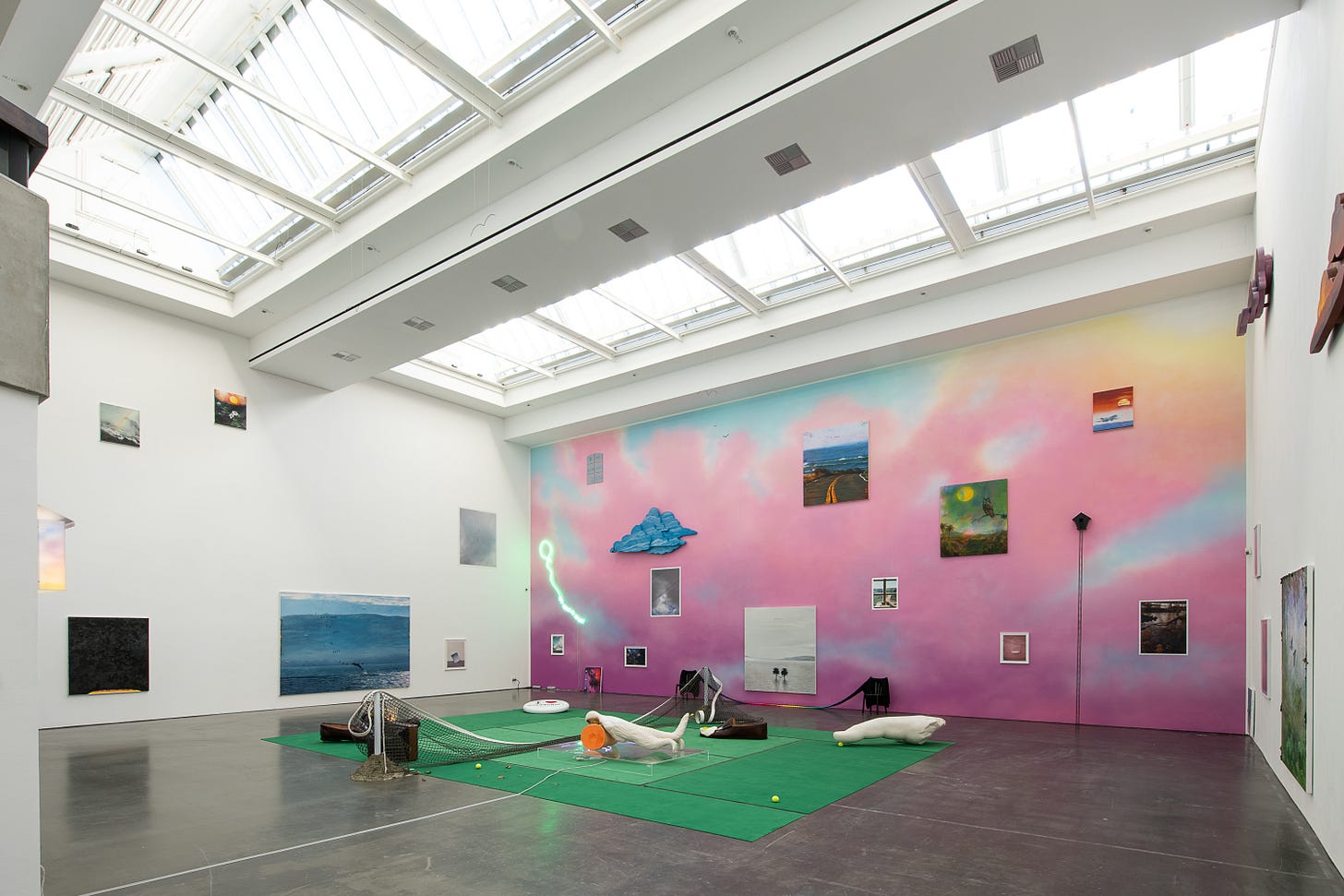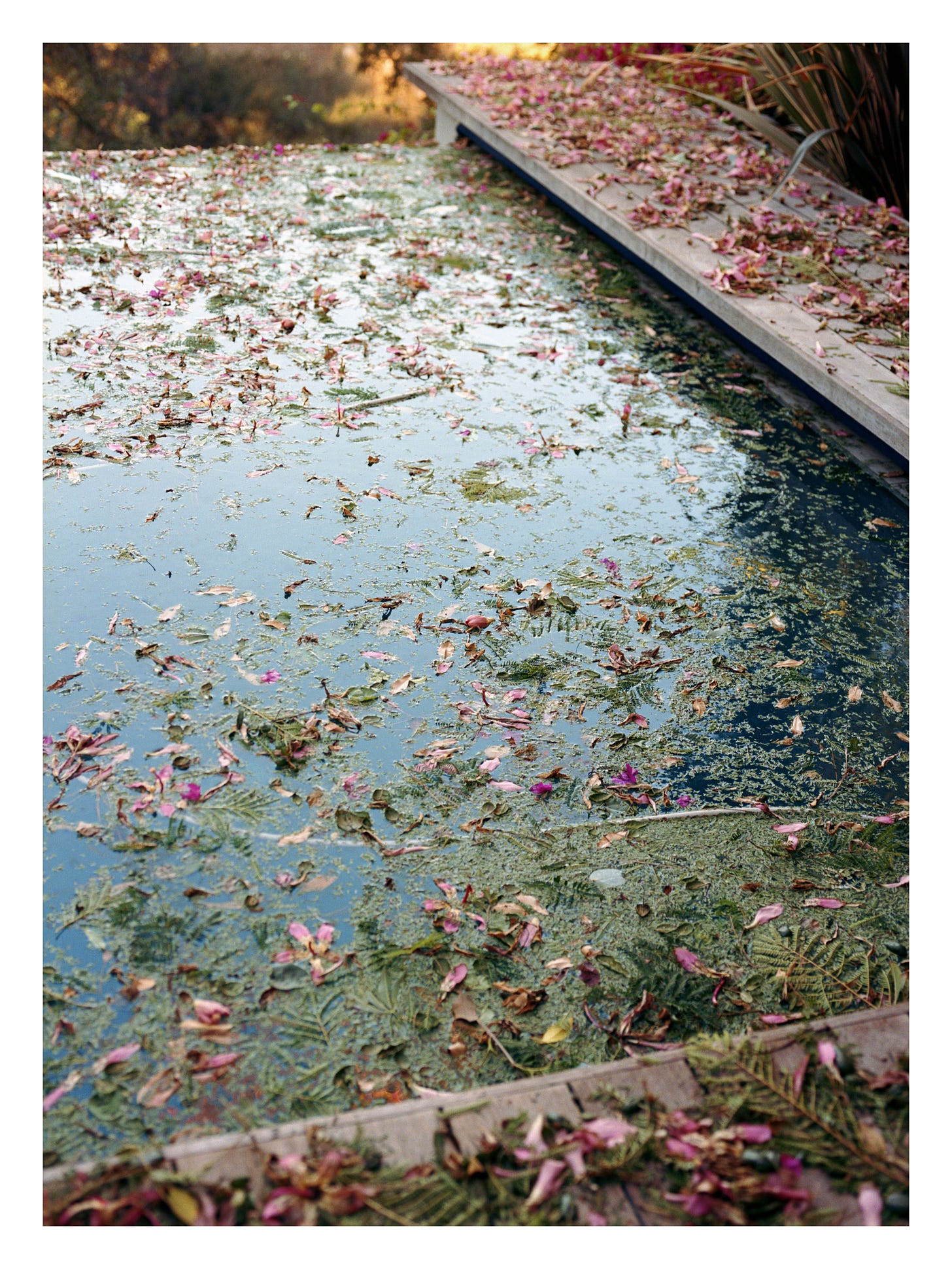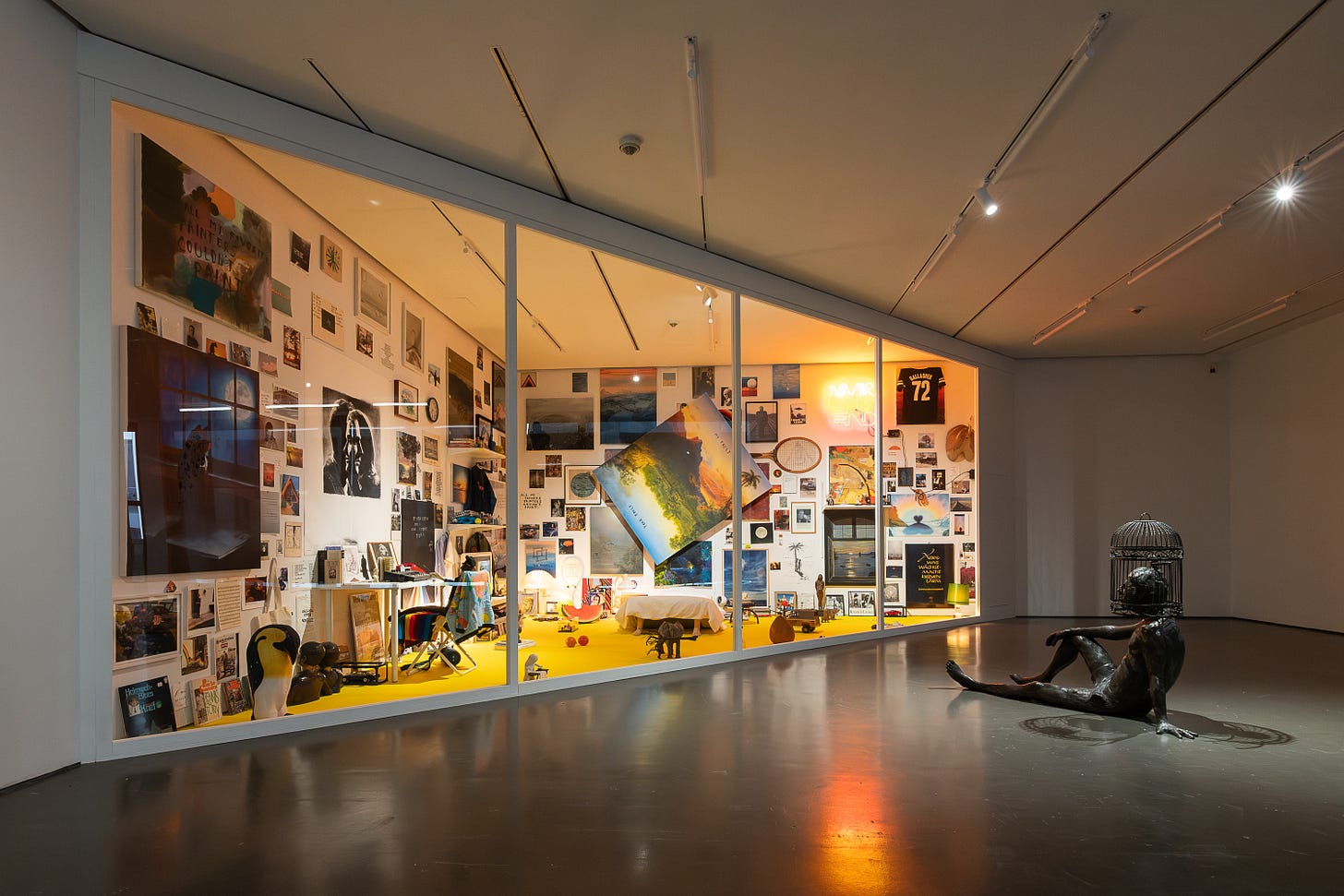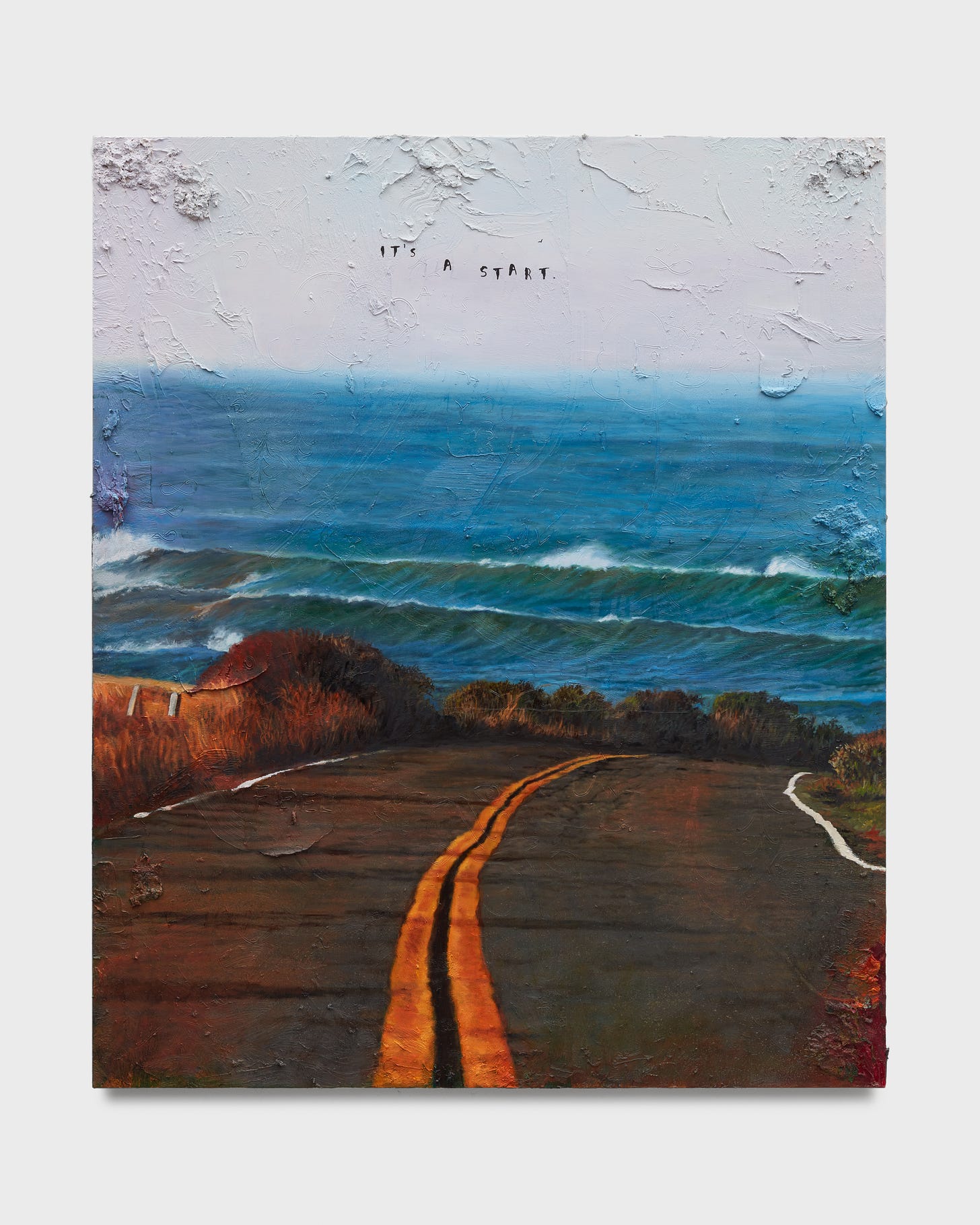The Tumblrification of Art? ONLY LOVERS LEFT at Kunsthalle Düsseldorf
Writing about this one was tough. Why? I genuinely enjoyed the exhibition. But what does a show on romanticism and modern day romance offer beyond being candid & cute?
When the party’s over
The illusion of a pretty pink sunset sky that instinctively makes me reach for my phone to take a picture is broken by the paintings and photographs hanging on it. Two chairs hold hands through two black cardigans sharing a long, rainbow-colored sleeve. If somebody told me it was snatched from Harry Styles’ 2020 Vogue photoshoot, I’d believe it.
White monolithic chunks of what might have been an ancient monument once are shattered around a tennis court. It’s easy to trip over the tennis balls all around. An old TV screen is flickering again with the help of neatly stacked colored socks inside. A huge I Love Melancholy badge rests in a corner. The tennis net is loose, extinguished cigarettes are buried in the sand inside of comically large dressing shoes. Somebody cracked an egg. Almost forgot the meerkatz and otter figures here and there. Looks like nobody wanted to stay for the clean-up after the party.
Upstairs, the laces of Adidas sneakers untie themselves, morphing into the sketched arches we were all taught to recognize as birds flying into the sunset. That’s where the protagonist heads. That’s where the love interests share their first on-screen kiss in their final scene after their lenghty love confessions. The sunset is the good ending to a good story.

#CoupleGoals (God, that’s such a cringe headline)
Friedrich Kunath (Gen X, German) & Margarete Jakschik (Gen X, Polish) live together in LA since 2007. He is from Chemnitz. She is Polish-born. Can I make it anymore obvious? He is a painter, she does photography. What more can I say? Through their work, the Kunsthalle takes a closer look at how American imagery shaped the ideas of romance and Romanticism here and now.
What is Romanticism? The simple answer is: a movement of the arts that started in central Europe in the 18th century. But what is Romanticism? That’s tricky. I’d say yearning. A yearning to satisfy a need you can’t put into words. A longing for home. A desire to go look for something you don’t have the vocabulary to define. However you express that feeling, that’s Romanticism.
In the 18th century, when Romanticism became a thing, Caspar David Friedrich (1774-1840, German) was the Sofia Ritchie of painting. His vast landscapes instilled a sense of awe, the feeling that we lil humans are just sooo teeny tiny in comparison to the greatness of nature, God, or whatever you want to name it. Friedrich Kunath not only gives him a cameo here and there, but often uses similarly impressive landscapes for his paintings.
Looking at his works is like watching a movie: You are completely imersed in the plot. Then, the camera slowly zooms out until the image starts flickering and blurring and you realize that was another TV screen you saw on your TV screen. Friedrich achieves this sensation through texture, smudging paint in some parts instead of evening it out or scratching phrases into the wet paint just enough to barely make out these subtle graffiti.
When the relatable turns… generic?
The texts Friedrich adds to his paintings are most often short and sweet. The energy all innocent like a paper scrap passed around in Middle School with Will you go out with me? yes, no, maybe and three tick boxes on it. Pretty much Instapoetry. The phrases you see on Pinterest and the Instagram discovery page if your algorithm believes you are a suburban teenage girl. You know, those short poems that want to sound deep and thought-provoking with the most generic content.
As I’m writing, you might have noticed that all my focus goes to Friedrich’s paintings and none of it to Margarete’s photographs. While Friedrich’s installations and paintings pull me in to explore the witty details (there are far more than I could possibly squeeze in here), Margarete’s photographs … simply look nice: Petals in a pool, a broken heart pendant missing its other half, a couple watching the sun set over the sea. What more can these photographs give me that my lockscreen and my Saves on Pinterest can’t?
What else is there? Where is the heartshattering longing? The borderline suicidal yearning? When I compare this show to Dorothy Iannone (1933-2022, American) in Antwerp, there was an earnest longing, a sincere vulnerability. It was extremely personal and therefore more than just relatable. Here in Düsseldorf, romanticism becomes generic. The word lover loses all its meaning in between easily digestible tumblr quotes. So I asked myself: Isn’t this maybe the whole point?

The show happens to fall into a time when especially my generation is embracing past aesthetics: coquette-core, cottage-core, hopeless romantics yearning for intimacy past avoidant situationships. Is Gen Z reviving Romanticism? And my generation receives not necessarily undeserved criticism: We might have traded “real” love for a curated aesthetic of it. Boyfriend material. Girlfriend material. Gen Z evolved past the Millenial #CoupleGoals with soft launches and relationship archetypes beyond Golden Retriever BF & Black Cat GF.
Balancing borderline kitsch
To me, the success of this exhibition depends on the intention. I can’t tell whether it’s an ironic look at how love has lost all meaning or whether it’s lost in its sheer overabundance in the show.
The main difference between Friedrich and Caspar is that while Caspar is dead serious about the indomitable human spirit (RIP Caspar, you would have loved hope-core), Friedrich likes an ironic and lighthearted take on being human. Margarete’s perspective remains a mystery to me. But even the use of irony has its constraints. Remember the tennis court earlier? The badge, the shoes, the monument, everything is huge. The haha in King Bach pulling out the infamous comically large spoon is that the spoon is comically large compared to the otherwise ordinary environment. If everything is bulky, over the top, and screaming for attention, then that becomes the default.

Recently, I came across the ArtReview article Is Contemporary Art a Pleasure-Free Zone? by Martin Herbert. He observes the general tendency in the art world right now to look at art analytically and seriously, even when the art itself is (about) fun. Am I falling into the exact trap that Martin warns me about? Maybe. Is depth necessary at all when talking about light romance? Wouldn’t that be even weirder?
So the show is as playful and whimsical as romance itself. And maybe that’s the way it should be. And when the party’s over, only lovers are left.
Gaze into the sunset at ONLY LOVERS LEFT through June 6, 2024, at Kunsthalle Düsseldorf.
Kunsthalle Düsseldorf
Grabbeplatz 4
40213 Düsseldorf
Website
Instagram: @kunsthalleduesseldorf
Right now I’m full on in study mode for the Biennale. Can’t wait to share exhibitions in Venice with you! For now, feel free to check out my Venice reviews from last year and don’t forget to subscribe to stay up to date!
See you soon!!!
Jennifer
The Gen Z Art Critic





Hey jennyfromtheblock, I really really enjoyed this blogpost. I have to go and see the exhibition myself now since the topics you’re touching on here are the focus of my current thought processes regarding my M.A. thesis. Big fan of your work, keep it going 🍒